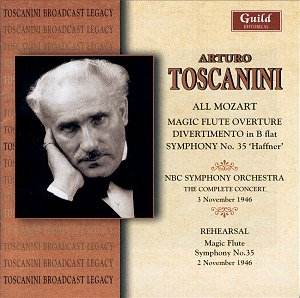Toscanini was and is a controversial conductor,
a controversial personality, and this disk will feed that image.
The Mozart Divertimento is not often played;
evidently Toscanini’s motivation for performing it (and later
recording it) was that Koussevitsky had performed it recently
and omitted the violin cadenza at the close of the slow movement
(during which movement the horns are silent). Toscanini insisted
in performing the work with cadenza to show up Koussevitsky.
Even the radio commentator was surprised at the decision to use
the entire string sections of the NBCSO to perform a work originally
written for string quartet, and the result justifies such scepticism.
As in other cases of Toscanini ‘orchestrating’ string quartet
music, the sound is scrappy, heavy, and unmusical. The violin
cadenza sounds remarkably like the one in Grofé’s Grand
Canyon Suite, and it is remotely possible that it actually
was Ferde Grofé himself playing first violin in the NBC
Symphony Orchestra at that time, although I find no record to
confirm this.
In Mozart’s time K287 was occasionally performed
as a violin concerto (with Mozart himself as the soloist), hence
its alternative Köchel listing as # 271h. In its variations
use is made of folksong tunes commonly associated with vulgar
words, perhaps as a sort of private joke with the countess for
whom it was originally written.
As with another Toscanini recording in this series,
the actual broadcast performance of the Mozart ‘Haffner’ Symphony
is quite good, but those snippets of the work from the rehearsal
section are much better. Apparently Toscanini could fire up the
musicians with insults and scolding and appeals to their sexual
nature, but by the time of performance, some of the fire would
inevitably have died down — a good argument in favour of studio
recordings. The performance of the Magic Flute Overture is unremarkable,
and features rapid tempi, strident recorded sound, and scrappy
string playing.
Paul Shoemaker
